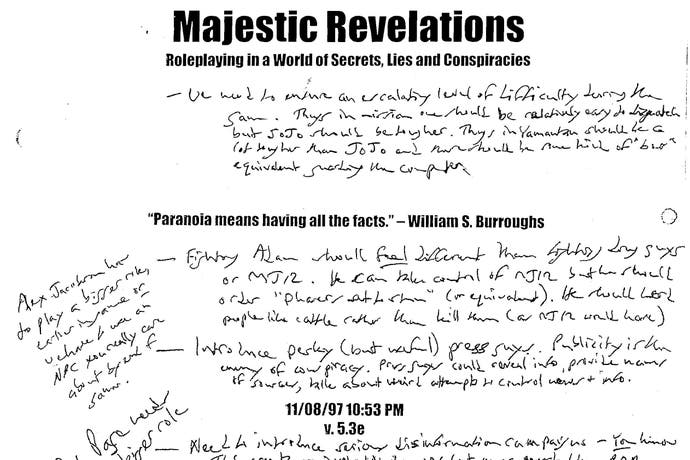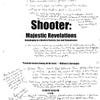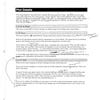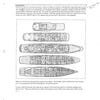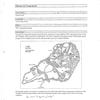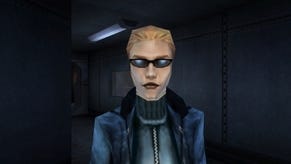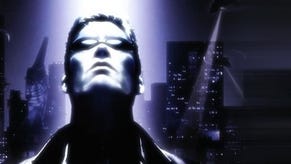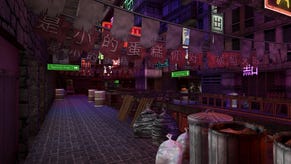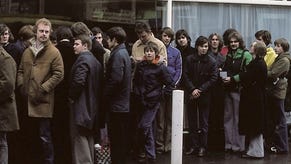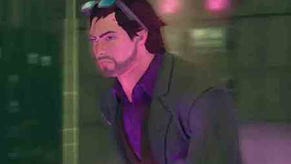The deleted scenes of Deus Ex
Dissecting a masterpiece with the original designers, and the original design document.
Examine Warren Spector's personally annotated copy of the first Deus Ex design document and you can immediately tell that production wasn't entirely smooth. The pages are littered with alterations and strikeouts, the only section left unmarked the marketing spiel in the preamble. It refers to the game by its working title, Majestic Revelations.
"[Revelations is a] near future science fiction with elements of conspiracy theory and X-Files weirdness," explains the summary text, the genre of the nascent game listed as 'RPG Adventure' with Christmas 1998 the slated release date. In reality the game didn't hit shelves until mid-2000, and by then it had drifted so far from the original vision that title wasn't even in the same language.
"Warren once commented that in the beginning he envisioned the game as X-Files but he somehow ended up with James Bond," reflects lead writer Sheldon Pacotti, looking back on how the game matured.
While much of the game evolved during production, there's also a lot that stayed the same. In the earliest scripts you're still cast as JC Denton, wearer of long coats and augmented super-spy for anti-terrorist force UNATCO. It's just that UNATCO is instead called TLC, the cute initialism standing for the slightly more cynical 'Terrorist Limitation Coalition'.
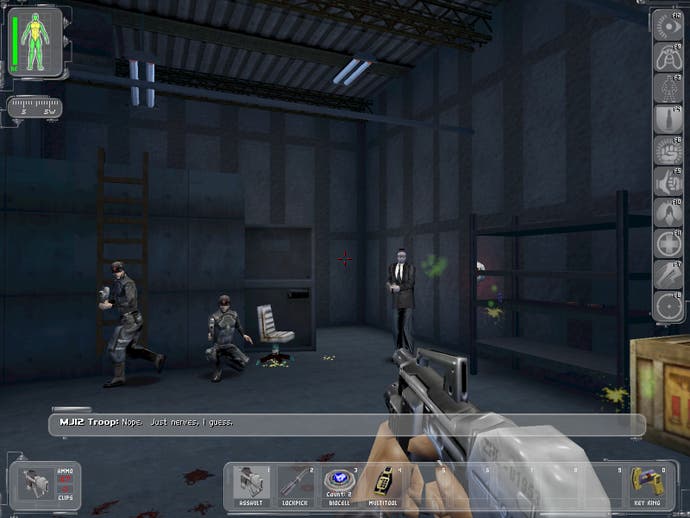
The story starts the same, although differences gradually emerge and then snowball over time. Tracer Tong is still the hacker who saves your life, for example, but in the original script he's very different to the kindly anarchist of the finished piece; he's "a mercenary ally," and a lot more like his mercurial father in Human Revolution.
It's the enemies who reflect the changes the most, however. UNATCO boss Joseph Manderley was little more than a stuffy bureaucrat in Deus Ex, but in Revelations he's "a ruthless bastard" who pursues you across the world and goes down fighting. Villains such as Majestic 12 leader Bob Page and assassin Anna Navarre are meanwhile barely mentioned, and are there as mere supports to prop up bigger scoundrels.
Then there's Majestic 12 itself. In Deus Ex the group is secretive and untouchable; in Revelations they're openly aggressive and effortlessly slaughtered by a rampant AI. Their plan is to destabilise the US by engineering a Mexican invasion of Texas, then assassinate the entire cabinet by cutting off air to the Presidential bunker - not just have Bob Page take control of the internet. When their plan fails, their own AI kills them and absconds to space with an arsenal of nuclear weapons. As Majestic Revelations matured into Deus Ex it kept these core characters and twists, but altered their roles drastically.
"When a game design changes, it's much easier to ask how the current characters fit than to invent new ones," Pacotti explains. "The original design document is packed with dozens of character ideas...They endured as people in the final game, but their true selves changed to fit the design."
"Most successful stories coalesce around the characters at their centre and that's what happened with Deus Ex," Sheldon continues, describing the cull as an organic evolution that occurred over time. "I see the movement toward a more personal story as a natural refinement."
"Very often a story is about just a handful of characters. And I think that was part of the problem; I had this sense that [Majestic Revelations' plot] was too crazy, too much." - Harvey Smith
Story wasn't the only reason for editing Deus Ex away from its original vision, however - fiscal and technological realities played a role too. Sheldon mentions a mid-game level in the White House level as a particularly complex task for the level designers to realise and the decision was ultimately made to focus that effort elsewhere. In a post-mortem lecture filmed in 2008, Warren Spector lays decisions like this at the feet of designer Harvey Smith.
"On a daily basis I was building the rooms," explains a humble Smith. "So, I knew how big a room could be before the renderer would choke and how many guys we could have on screen. I had an intimacy with the tools."
Armed with this technological understanding, Smith approached Spector and argued for what he considers the two most critical changes to the original vision. The first was a new skill system with fewer abilities but more demonstrable effects - so the guns didn't do more damage but instead got easier to use as you advanced. The second was a trimmed down version of the story that abandoned the Mexican invasion and space stations in order to become more technologically feasible and narratively intimate.
"If you think of a game from outside you very often add way too much to it and way too many characters," explained Smith, retrospectively. "That's fine if you're making a sim game, but very often a story is about just a handful of characters. And I think that was part of the problem; I had this sense that [Majestic Revelations' plot] was too crazy, too much."
Smith's new version of the plot sought to reuse completed assets wherever possible, but abandoned sections that weren't already in development. Much of Majestic Revelations would have been set in war-torn Texas or bizarrely around Denver airport, but these ideas were never even prototyped, discarded to allow focus elsewhere. An underwater city in a flooded Hollywood valley became a secret MJ12 research base. The Helios space station where the game would have ended (with nuclear explosions in space, no less) was repurposed for Area 51, meaning the team didn't have to struggle with coding zero-gravity combat.
The White House and the President's nuclear bunker were notable exceptions, however. These were levels that were definitely made to some rough yet playable state, but were cut from the game entirely. These are the truly deleted scenes of Deus Ex - Ion Storm's lost levels.

"It's possible they exist on DVDs in someone's attic, somewhere," says Pacotti, although he doesn't sound confident. All that he knows for sure is he doesn't have them - and Harvey says the same too. Even Spector's personal archives don't have anything more than documentation and a few forgotten interviews, meaning the only traces are some mysterious references left on the game disk. Modders such as Jonas Waever have scoured the DVDs thoroughly for even shell files, but there's nothing but empty folders pointing to the two missing missions.
Ultimately though, the loss of these semi-finished levels isn't something which the old team sees as a big problem. Instead, what's important is that in cutting it, they were able to work elsewhere and end up with a more focused experience.
"At the same time as missions like the White House were being cut, others - like the one where you can rescue Paul - were being expanded," says Pacotti. "So, as much as I'd like to play West Wing: The Videogame, I think interacting with Paul is much more interesting."
In the end, it's hard to argue with that sentiment - the idea of character-driven interaction was one of the things that made Deus Ex great, not the fact that it had levels in recognisable places. The 1997 story draft of Majestic Revelations opens with a sort of design manifesto for the project and the recurring theme is that character development should be prioritised over everything else. No weird game spaces, no technological ambitions for the sake of it; character development is all that matters and it's spelled out through sections titled 'Deep Simulation, Small Environment', 'Problems, Not Puzzles' and 'Believable, Object-Rich Worlds'
"We want character development to be a vital part of the game," reads one part. "If, by game's end, we can make each character unique (and, therefore, each player's experience of the game, each player's unique), then we win."
